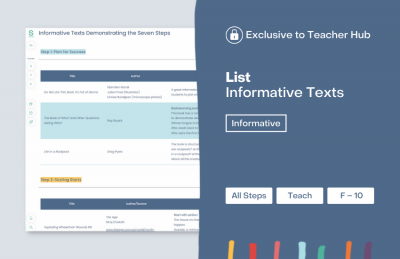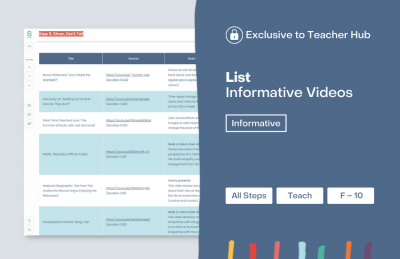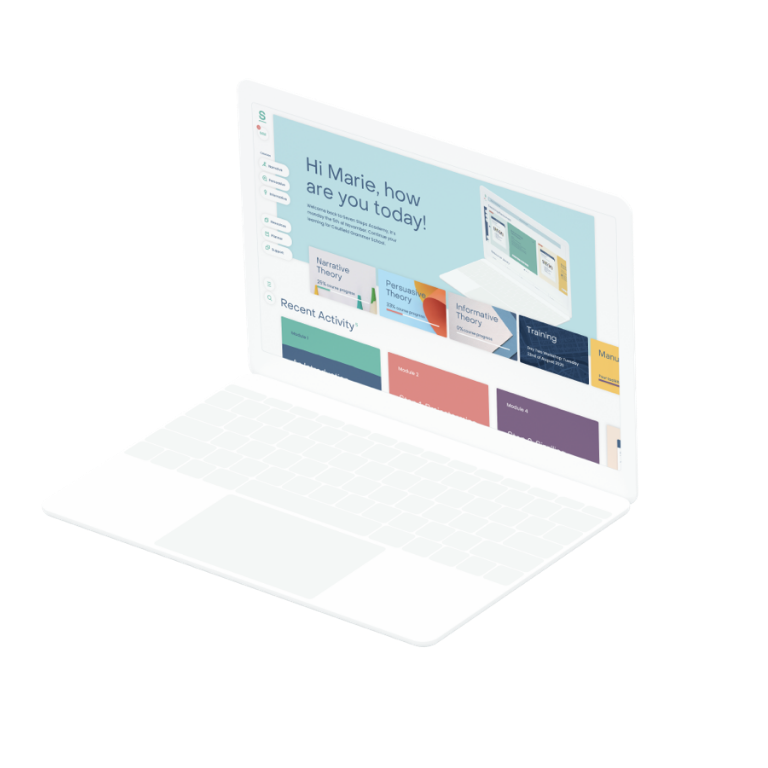No products in the cart.

4 min

Classroom Activities

Admin SEVEN STEPS
Facts can be as fun as fiction
So, what is informative writing? At its simplest, any text that seeks to ‘inform’.
This includes a fabulous variety of things like:
- reports
- emails
- documentaries
- news articles
- sports reports
- science experiments
- even things like the description of how a fridge works!
In this wonderful digital era, texts are completely multimodal – they can be written, spoken, filmed, or any combination of these.
What’s important for students is for fun to be injected into informative writing lessons. Facts are one thing – but engaging facts, written in a powerful way? That’s something a reader wants.
As students reach the upper years of schooling, informative writing becomes increasingly important. And in adult life, factual, informative writing is probably the type of writing we will use the most.
Learning should be dynamic!

How the Seven Steps can improve informative writing
The good news is that if you’ve already used the Seven Steps, so many of the techniques you are familiar with transfer to informative writing.
For an in-depth look at how to use the Seven Steps in informative writing, join us at Workshop Two: Putting It All Together.
If you’re new to the Seven Steps, these techniques are really simple to learn (Workshop One: Seven Steps to Transform Writing).
We make it simple for students by teaching the techniques in small manageable chunks, so students master each one before moving on. All kinds of informative texts can be improved using the Seven Steps techniques. For example:
Step 1: Plan for Success
To develop a science report, students need to brainstorm, research, gather information and find the most interesting or important facts to include in their writing. They then need to develop well-structured, logical and clear plans.
Step 2: Sizzling Starts
The introduction to an information report needs to give the reader a quick insight into the topic, but even more importantly it needs to make the reader want to read more. Which facts will your students use to do this? [ Try Step 2: Sizzling Starts]
Step 3: Tightening Tension
Just like a Nat Geo documentary, a great informative text builds up momentum and reaches a high point just before the ending. Informative texts can be real nail biters!
Step 4: Dynamic Dialogue
Real words by real people are much stronger than simply stating facts. Effectively using eye-witness accounts or expert quotes can bring a news report to life!
Step 5: Show, Don’t Tell
Facts are important, but facts just tell. Strong writers engage their readers by making them see, feel and care about a topic. Describing the fear in an impala’s eyes moments before a lion pounces is far more engaging than simply stating ‘Impala are often prey for lions.’
Step 6: Ban the Boring
Ever seen a diamond in the rough? It’s a pretty boring stone. But after it has been cleaned and polished, it’s a wonder to behold. Teach your class about structural editing, expression editing and line editing and let your students’ writing shine!
Step 7: Ending with Impact
Reports shouldn’t fizzle out with the same old boring ‘in conclusion…’ They should leave your reader satisfied, inspired or ready to take action.

Teacher Hub
Try these handy lists which include several different informative texts, such as books, web pages, news articles and videos, organised by Step. Use these texts and videos to model what the Seven Steps look like in action.
Informative Texts Demonstrating the Seven Steps
- Show students examples of the Seven Steps techniques in published texts.
- This handy list is sorted by Step and annotated with notes about how each text demonstrates a particular Seven Steps technique.
- Selection includes picture books, news articles and science comics.
STEP All Steps
PURPOSE Teach
RESOURCE TYPE List
YEAR F–10


Informative Videos Demonstrating the Seven Steps
- Show students examples of the Seven Steps techniques in filmmaking.
- This handy list is sorted by Step and annotated with notes about how each video clip demonstrates a particular Seven Steps technique.
- Selection includes news reports, documentary scenes and educational videos.
STEP All Steps
PURPOSE Teach
RESOURCE TYPE List
YEAR F–10


Try an informative Teacher Hub Action Activity!
Use this short classroom activity to practise the technique and build students’ muscle memory. This activity is designed for students in lower primary, or older writers who need extra support.
Box of Goodies (Step 1)
A great starting point for any topic of study is to connect with students’ personal experiences.
Create a box of items relating to the topic. For example, if the topic is Australia, the box might contain a boomerang, a jar of Vegemite, a gum nut, an Australian flag, a piece of Aboriginal art, etc.
Get students to sit in a circle and ask a volunteer to pick an item out of the box. Get the student to explain how the object relates to the topic and describe any personal experiences they have with the object, e.g. eating Vegemite on toast or waving the flag on Australia Day.
Get other students to pick an object out of the box and repeat the activity until everyone has had a turn or there are no objects left.
Looking for more classroom resources?
View the related blog: Fun with factual writing (4 picture writing prompts)

Bring factual writing to life
The Seven Steps Informative Writing Manual and Teacher Hub training and resources help you bring informative writing to life. In fact, the Informative Writing Manual won the Highly Commended award at the Educational Publishing Awards Australia 2019!









